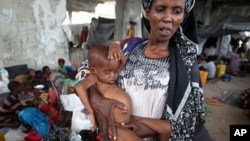The United Nations officially declared a famine in parts of Somalia, Wednesday, as malnutrition rates rise to extreme levels. The U.N. is now appealing for immediate action to keep the crisis from spreading to other parts of the region.
The United Nations says consecutive droughts over the last few years in Somalia have created a famine in two regions of the south.
Speaking at a news conference in Nairobi, U.N. Humanitarian Coordinator for Somalia Mark Bowden called it a “desperate situation.”
U.N. Humanitarian Coordinator for Somalia Mark Bowden speaking in Nairobi:
“We estimate that almost half of the Somali population, 3.7 million people, are affected by this crisis and a full 2.8 million people live in the south, the most seriously affected area," said Bowden. "It is likely that tens of thousands will already have died, the majority of these being children.”
What this means
|
Definition of Famine: The word famine is a term that is not used lightly by humanitarian organizations. The United Nations describes a crisis as a famine only when the following conditions are met:
Current Famine:
|
While the world has been watching a food crisis unfold in Somalia, this is the first time the United Nations has used the term “famine.”
That classification means that malnutrition rates have exceeded 30 percent, that more than two people per 10,000 are dying each day, and that many cannot get access to food and other essentials.
To be precise, the famine has only been declared in the regions of southern Bakool and Lower Shabelle in Somalia, but the U.N. warns it could spread to other areas in coming months.
Was this preventable?
Asked if the United Nations could have done more to prevent this crisis, Bowden told VOA that they did not have the resources.
“We had been hoping to avoid famine, we spent a lot of our resources that we had at the beginning of the years specifically to help those communities that we thought might migrate, to stop migrations which is one of the major causes of death," said Bowden. "We spent our money, we didn't have enough to scale up as we now need to.”
Now, the U.N. says $300 million is urgently needed during the next two months to address the crisis.
Much of the money will be used to tackle immediate needs, by supplying existing feeding centers and providing medical services for affected areas.
The funds will also be used to help sustain local economies by providing cash for work and other livelihood assistance for farmers.
Main objectives
The head of the U.N. Food and Agriculture Organization for Somalia, Luca Alinovi, says the objective is to keep people from fleeing the areas.
“We have to remember that we are in the making of an incredible disaster," said Alinovi. "The famine is eating already two regions, there are more regions on the edge of becoming in that condition and people will move out. The only way to prevent people moving out is to make sure that they have hope for the future - they can make something out of their lives. How can they do that? They can do that only if they feel that in the next few months they will be in condition to produce their food.”
Complicating relief efforts, the two famine areas in Somalia also happen to be the strongholds of the Islamist militant group al-Shabab. The group, until recently, had banned foreign assistance. Its members have also been known to hijack food and aid deliveries, creating some hesitation from foreign donors.
Mark Bowden said the U.N. is doing what it can to minimize the risk posed by al-Shabab and is in discussions with local leaders in Somalia to gain support for its efforts.
He said while there is always a risk of operating in Somalia, this famine requires what he called, "exceptional actions."













